汉字的发展(英文版介绍)Chinese__character
- 格式:ppt
- 大小:6.49 MB
- 文档页数:44
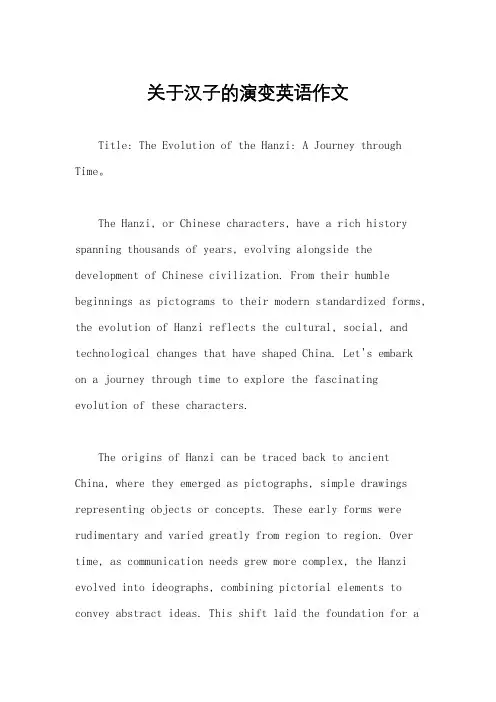
关于汉子的演变英语作文Title: The Evolution of the Hanzi: A Journey through Time。
The Hanzi, or Chinese characters, have a rich history spanning thousands of years, evolving alongside the development of Chinese civilization. From their humble beginnings as pictograms to their modern standardized forms, the evolution of Hanzi reflects the cultural, social, and technological changes that have shaped China. Let's embark on a journey through time to explore the fascinating evolution of these characters.The origins of Hanzi can be traced back to ancient China, where they emerged as pictographs, simple drawings representing objects or concepts. These early forms were rudimentary and varied greatly from region to region. Over time, as communication needs grew more complex, the Hanzi evolved into ideographs, combining pictorial elements to convey abstract ideas. This shift laid the foundation for amore sophisticated writing system that could express a wide range of meanings.During the Shang Dynasty (1600–1046 BCE), the use of oracle bones for divination led to the standardization of certain characters, marking the beginning of formalized script. The Zhou Dynasty (1046–256 BCE) further refined the script, introducing bronze inscriptions that displayed a more structured and stylized form of writing. This period witnessed significant advancements in calligraphy, as scholars and artisans developed elegant scripts that became symbols of culture and prestige.The Qin Dynasty (221–206 BCE) brought about a major milestone in the evolution of Hanzi with the standardization of script across the empire. Qin Shi Huang, the first emperor of unified China, implemented a uniform script known as Small Seal Script, which replaced regional variations and promoted linguistic unity. This standardization facilitated governance, commerce, and cultural exchange, laying the groundwork for the dissemination of Chinese writing beyond its borders.The Han Dynasty (206 BCE–220 CE) saw further developments in Hanzi, including the emergence of clerical script, a more streamlined and cursive style suited for bureaucratic use. This script became the official writing style of the Han court and remained influential forcenturies to come. Meanwhile, regular script, characterized by its balanced proportions and fluid strokes, gained popularity among scholars and literati for its aesthetic appeal.The invention of paper during the Han Dynasty revolutionized the production and dissemination of written materials, leading to a proliferation of literature, poetry, and scholarship. This period witnessed a golden age of Chinese culture, with Hanzi serving as the medium forartistic expression, philosophical discourse, andhistorical documentation. Calligraphy, in particular, flourished as a revered art form, with master calligraphers admired for their skillful manipulation of brush and ink.The Tang Dynasty (618–907 CE) marked another goldenage of Chinese civilization, characterized by cultural flourishing and cosmopolitanism. This era saw the widespread adoption of regular script as the standard writing style, reflecting its elegance and practicality for everyday use. Tang calligraphy reached new heights of sophistication, with artists like Yan Zhenqing and Liu Gongquan renowned for their mastery of the brush.The Song Dynasty (960–1279 CE) witnessed the development of new script styles, such as the graceful and fluid running script, which prioritized speed andefficiency without sacrificing aesthetic beauty. This period also saw the invention of movable type printing, a technological breakthrough that revolutionized the production of books and disseminated knowledge to a wider audience.The Ming (1368–1644 CE) and Qing (1644–1912 CE) dynasties saw further refinements in Hanzi, with the standardization of script and the compilation of comprehensive dictionaries to preserve the richness and diversity of the Chinese language. Despite politicalupheavals and foreign invasions, the writing system remained a symbol of cultural continuity and resilience, adapting to changing circumstances while retaining its essential character.In the modern era, the widespread adoption ofsimplified characters in mainland China and the continued use of traditional characters in Taiwan, Hong Kong, and Macau reflect divergent approaches to language reform and cultural identity. Yet, despite these differences, Hanzi remains a unifying force that transcends regional and national boundaries, connecting Chinese speakers around the world through a shared written heritage.In conclusion, the evolution of Hanzi is a testament to the enduring vitality and adaptability of Chinese civilization. From its origins as simple pictograms to its modern incarnations as standardized characters, Hanzi has evolved in response to cultural, social, and technological changes, shaping and reflecting the trajectory of Chinese history. As we continue to navigate the complexities of the modern world, the study and appreciation of Hanzi offervaluable insights into the rich tapestry of Chinese culture and the human capacity for creativity and innovation.。
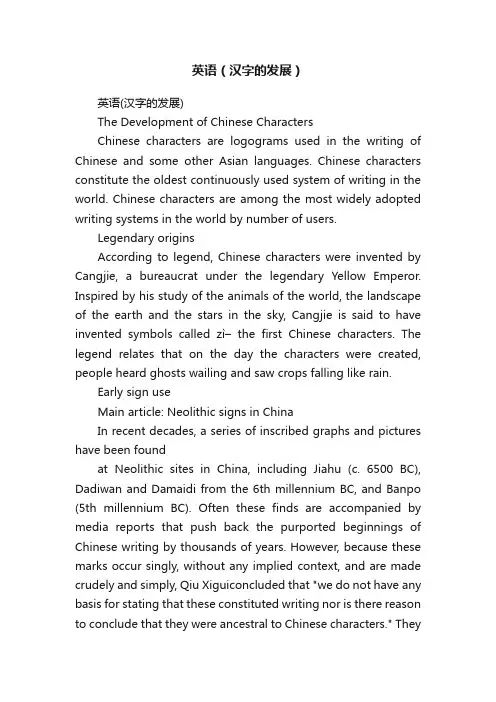
英语(汉字的发展)英语(汉字的发展)The Development of Chinese CharactersChinese characters are logograms used in the writing of Chinese and some other Asian languages. Chinese characters constitute the oldest continuously used system of writing in the world. Chinese characters are among the most widely adopted writing systems in the world by number of users.Legendary originsAccording to legend, Chinese characters were invented by Cangjie, a bureaucrat under the legendary Yellow Emperor. Inspired by his study of the animals of the world, the landscape of the earth and the stars in the sky, Cangjie is said to have invented symbols called zì–the first Chinese characters. The legend relates that on the day the characters were created, people heard ghosts wailing and saw crops falling like rain.Early sign useMain article: Neolithic signs in ChinaIn recent decades, a series of inscribed graphs and pictures have been foundat Neolithic sites in China, including Jiahu (c. 6500 BC), Dadiwan and Damaidi from the 6th millennium BC, and Banpo (5th millennium BC). Often these finds are accompanied by media reports that push back the purported beginnings of Chinese writing by thousands of years. However, because these marks occur singly, without any implied context, and are made crudely and simply, Qiu Xiguiconcluded that "we do not have any basis for stating that these constituted writing nor is there reason to conclude that they were ancestral to Chinese characters." Theydo however demonstrate a history of sign use in the Yellow River valley during the Neolithic through to the Shang period.Oracle bone scriptThe earliest confirmed evidence of the Chinese script yet discovered is the body of inscriptions carved on oracle bones from the late Shang dynasty (c. 1200–1050 BC). In 1899, pieces of these bones were being sold as "dragon bones" for medicinal。
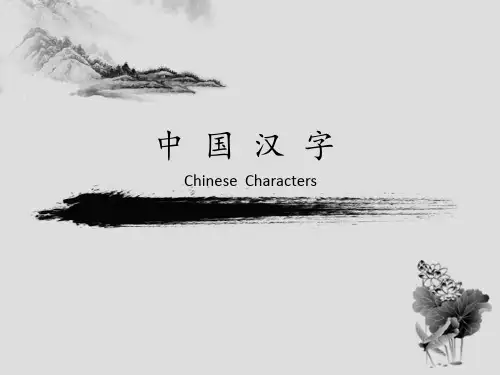
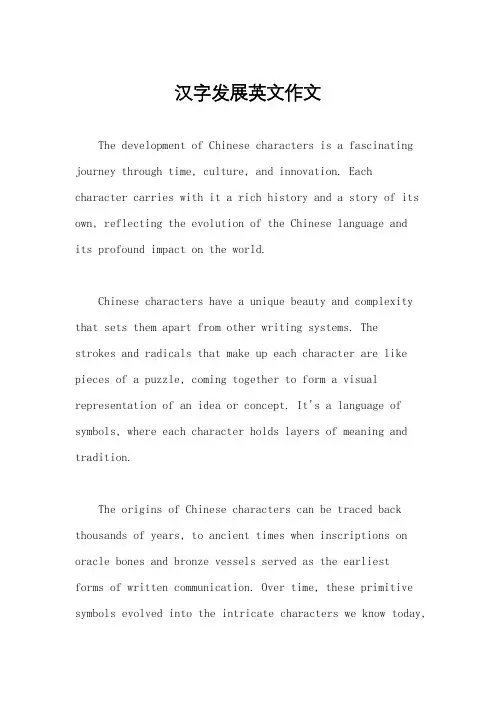
汉字发展英文作文The development of Chinese characters is a fascinating journey through time, culture, and innovation. Each character carries with it a rich history and a story of its own, reflecting the evolution of the Chinese language andits profound impact on the world.Chinese characters have a unique beauty and complexity that sets them apart from other writing systems. Thestrokes and radicals that make up each character are like pieces of a puzzle, coming together to form a visual representation of an idea or concept. It's a language of symbols, where each character holds layers of meaning and tradition.The origins of Chinese characters can be traced back thousands of years, to ancient times when inscriptions on oracle bones and bronze vessels served as the earliestforms of written communication. Over time, these primitive symbols evolved into the intricate characters we know today,shaped by the influence of different dynasties, cultural exchanges, and technological advancements.The spread of Chinese characters beyond China's borders has had a profound impact on global communication and understanding. As Chinese culture and language have spread around the world, so too have its characters, finding their way into the written systems of other languages and leaving an indelible mark on global culture.The ongoing digital revolution has brought new challenges and opportunities for the development of Chinese characters. With the rise of technology, there is a constant tension between preserving the traditional art of calligraphy and adapting characters to fit the constraints of digital devices. However, this tension has also sparked creativity, leading to new forms of expression and designin the realm of Chinese typography.In conclusion, the development of Chinese characters is a testament to the enduring power of language and culture. From their ancient origins to their modern-day adaptations,Chinese characters continue to captivate and inspire, serving as a bridge between the past and the future.。
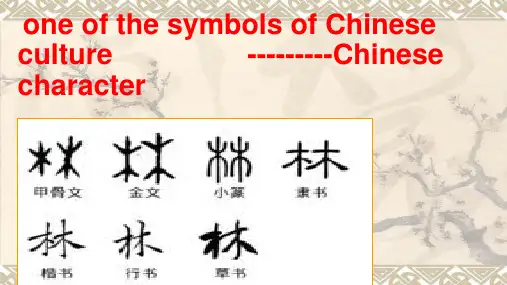
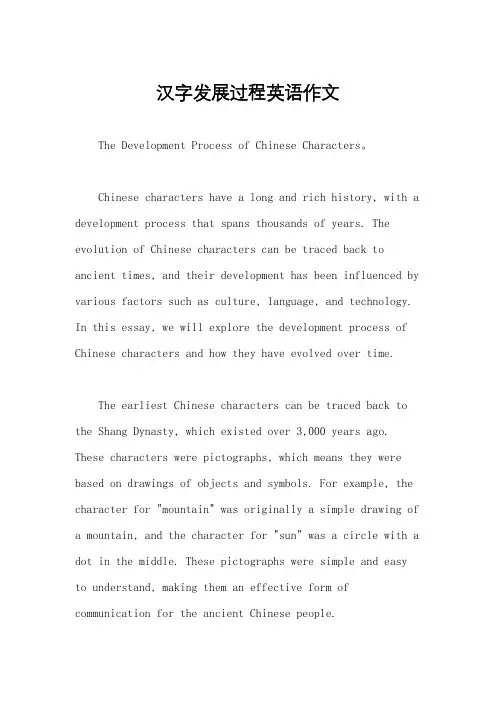
汉字发展过程英语作文The Development Process of Chinese Characters。
Chinese characters have a long and rich history, with a development process that spans thousands of years. The evolution of Chinese characters can be traced back to ancient times, and their development has been influenced by various factors such as culture, language, and technology. In this essay, we will explore the development process of Chinese characters and how they have evolved over time.The earliest Chinese characters can be traced back to the Shang Dynasty, which existed over 3,000 years ago. These characters were pictographs, which means they were based on drawings of objects and symbols. For example, the character for "mountain" was originally a simple drawing of a mountain, and the character for "sun" was a circle with a dot in the middle. These pictographs were simple and easy to understand, making them an effective form of communication for the ancient Chinese people.As time passed, the Chinese characters evolved from pictographs to ideographs. Ideographs are characters that represent ideas or concepts rather than physical objects. This shift in the structure of Chinese characters allowed for a more abstract and nuanced form of communication. For example, the character for "love" is a combination of the characters for "heart" and "friend," symbolizing the concept of affection and friendship.During the Qin and Han Dynasties, the Chinese characters underwent another significant change with the standardization of the script. This standardization was led by the first emperor of China, Qin Shi Huang, who sought to unify the writing system in order to facilitate communication and governance. The result was the creation of the small seal script, which became the standard form of writing for centuries to come.In the following dynasties, the Chinese characters continued to evolve, with the introduction of new styles of calligraphy and the development of printing technology. Thecalligraphy of the Tang Dynasty, for example, is renowned for its elegance and grace, and it had a profound influence on the development of Chinese characters. Additionally, the invention of woodblock printing during the Song Dynasty allowed for the mass production of books, which further spread the use of Chinese characters throughout China and beyond.In modern times, the Chinese characters have continued to evolve with the advent of technology. The development of computers and smartphones has led to the creation of simplified and traditional Chinese characters, as well as the adoption of Pinyin, a system for transcribing Chinese characters into the Latin alphabet. These advancements have made it easier for people to learn and use Chinese characters, and they have also facilitated the global spread of the Chinese language.In conclusion, the development process of Chinese characters is a testament to the rich history and culture of China. From their origins as pictographs to their modern-day use in technology, Chinese characters haveevolved in response to the changing needs of society. As a result, they continue to be an integral part of Chinese culture and a unique and fascinating form of writing.。
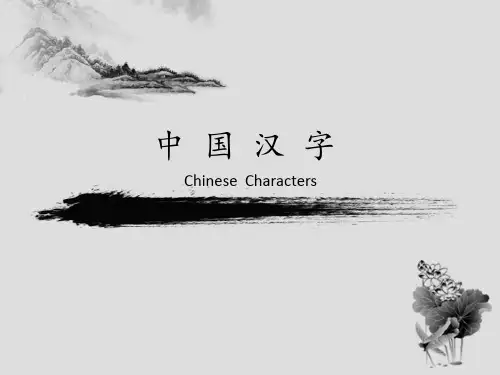
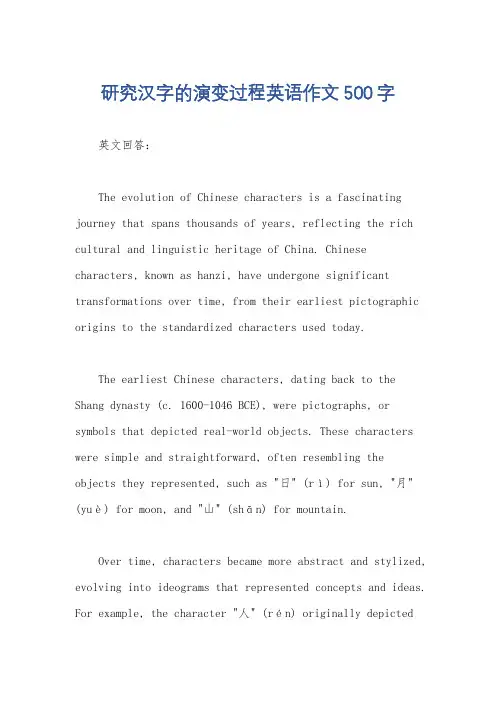
研究汉字的演变过程英语作文500字英文回答:The evolution of Chinese characters is a fascinating journey that spans thousands of years, reflecting the rich cultural and linguistic heritage of China. Chinese characters, known as hanzi, have undergone significant transformations over time, from their earliest pictographic origins to the standardized characters used today.The earliest Chinese characters, dating back to the Shang dynasty (c. 1600-1046 BCE), were pictographs, or symbols that depicted real-world objects. These characters were simple and straightforward, often resembling theobjects they represented, such as "日" (rì) for sun, "月" (yuè) for moon, and "山" (shān) for mountain.Over time, characters became more abstract and stylized, evolving into ideograms that represented concepts and ideas. For example, the character "人" (rén) originally depicteda person standing upright, but it later came to symbolize the concept of humanity in general.Beginning in the Warring States period (475-221 BCE), characters began to be combined to form new words and phrases. This process of compounding led to the creation of thousands of new characters, greatly expanding the Chinese vocabulary.The Han dynasty (206 BCE-220 CE) saw the standardization of Chinese characters. The scholar Li Si, under the emperor Qin Shi Huang, created a unified system of characters known as "small seal" script. This script formed the basis for the modern Chinese characters used today.During the Eastern Han dynasty (25-220 CE), the invention of paper and the widespread use of writing brushes led to further developments in Chinese calligraphy. The cursive and running scripts emerged, allowing forfaster and more fluid writing.The Tang dynasty (618-907 CE) witnessed a flourishing of Chinese literature and culture, and calligraphy became a highly respected art form. The development of new calligraphic styles, such as the regular script and the standard script, contributed to the refinement and elegance of Chinese characters.In modern times, the evolution of Chinese characters has been influenced by globalization and the advent of digital technology. While traditional characters remain in use, simplified characters have been adopted in mainland China to enhance literacy rates. The use of Chinese characters in electronic communication has also led to the development of new character sets and input methods.The evolution of Chinese characters is a testament to the enduring power of language and culture. From their humble origins as pictographs to the sophisticated symbols used today, Chinese characters have played a vital role in shaping the history and identity of China.中文回答:汉字的演变是一个跨越数千年的迷人历程,反映了中国丰富的文化和语言遗产。

汉字演变英语演讲稿范⽂ Today, my topic is changes in Chinese characters. Chinese culture is broad and profound. And I think, Chinese characters are also an important part of Chinese culture. At first, there was Oracle Bone Inscriptions. It was an ancient language. It was written on tortoise shell or animal bones. It recorded the political and economic situation in the Shang Dynasty. Then, there was inscriptions on ancient bronze objects (jin wen)。
Look at the picture! It was popular in the Zhou Dynasty. Next, there was seal character (zhuan shu)。
It was used in Qin Dynasty. Then, let’s look at this picture. It is called official script (li shu)。
It was usually very flat. It was begun to use in the Qin Dynasty. It became the most popular in the Han Dynasty. This is regular script (kai shu)。
As its name, it is very regular. It is very popular now, too. This is running script (xing shu)。
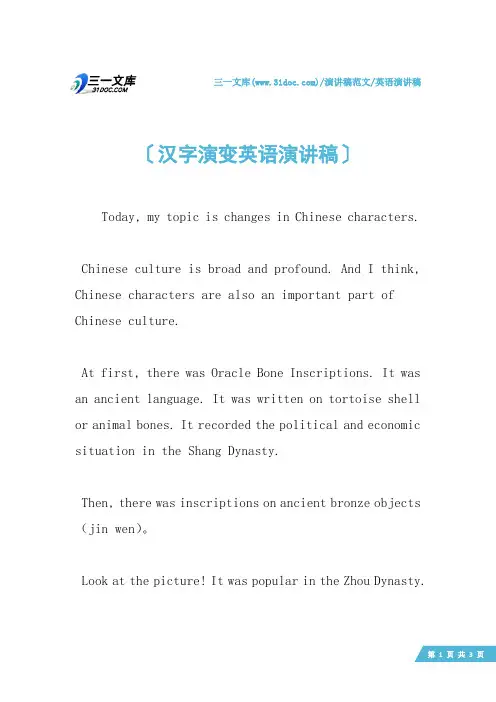
三一文库()/演讲稿范文/英语演讲稿〔汉字演变英语演讲稿〕Today, my topic is changes in Chinese characters.Chinese culture is broad and profound. And I think, Chinese characters are also an important part of Chinese culture.At first, there was Oracle Bone Inscriptions. It was an ancient language. It was written on tortoise shell or animal bones. It recorded the political and economic situation in the Shang Dynasty.Then, there was inscriptions on ancient bronze objects (jin wen)。
Look at the picture! It was popular in the Zhou Dynasty.Next, there was seal character (zhuan shu)。
It was used in Qin Dynasty.Then, let’s look at this picture. It is called official script (li shu)。
It was usually very flat. It was begun to use in the Qin Dynasty. It became the most popular in the Han Dynasty.This is regular script (kai shu)。
As its name, it is very regular. It is very popular now, too.This is running script (xing shu)。
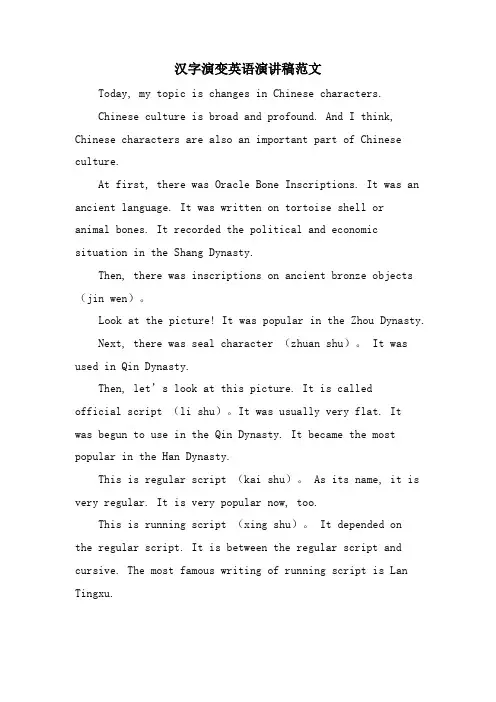
汉字演变英语演讲稿范文Today, my topic is changes in Chinese characters.Chinese culture is broad and profound. And I think, Chinese characters are also an important part of Chinese culture.At first, there was Oracle Bone Inscriptions. It was an ancient language. It was written on tortoise shell oranimal bones. It recorded the political and economic situation in the Shang Dynasty.Then, there was inscriptions on ancient bronze objects (jin wen)。
Look at the picture! It was popular in the Zhou Dynasty.Next, there was seal character (zhuan shu)。
It was used in Qin Dynasty.Then, let’s look at this picture. It is calledofficial script (li shu)。
It was usually very flat. Itwas begun to use in the Qin Dynasty. It became the most popular in the Han Dynasty.This is regular script (kai shu)。
As its name, it is very regular. It is very popular now, too.This is running script (xing shu)。
写汉语的发展的英文作文The development of Chinese language can be traced back thousands of years, evolving from ancient pictographs to the complex characters we see today.Chinese characters are not only a form of writing, but also a reflection of the culture and history of China. Each character carries its own meaning and pronunciation, making Chinese a unique and fascinating language.In recent years, the popularity of Mandarin Chinese has been on the rise, with more and more people around the world learning the language for business, travel, and cultural exchange.The rise of technology has also had a significant impact on the development of Chinese language, with the invention of pinyin input method making it easier for people to type Chinese characters on computers and smartphones.Despite the challenges of learning Chinese characters, many people are drawn to the beauty and complexity of the language, finding joy in mastering its intricacies and nuances.As China continues to play a prominent role on the global stage, the importance of Chinese language proficiency is only expected to grow, making it a valuable skill for anyone looking to succeed in the 21st century.。
Today, my topic is changes in Chinese characters.Chinese culture is broad and profound. And I think, Chinese characters are also an important part of Chinese culture.At first, there was Oracle Bone Inscriptions. It was an ancient language. It was written on tortoise shell or animal bones. It recorded the political and economic situation in the Shang Dynasty.Then, there was inscriptions on ancient bronze objects (jin wen)。
Look at the picture! It was popular in the Zhou Dynasty.Next, there was seal character (zhuan shu)。
It was used in Qin Dynasty.Then, let’s look at this picture. It is called official script (li shu)。
It was usually very flat. It was begun to use in the Qin Dynasty. It became the most popular in the Han Dynasty.This is regular script (kai shu)。
As its name, it is very regular. It is very popular now, too.This is running script (xing shu)。
中国汉字发展英文作文下载温馨提示:该文档是我店铺精心编制而成,希望大家下载以后,能够帮助大家解决实际的问题。
文档下载后可定制随意修改,请根据实际需要进行相应的调整和使用,谢谢!并且,本店铺为大家提供各种各样类型的实用资料,如教育随笔、日记赏析、句子摘抄、古诗大全、经典美文、话题作文、工作总结、词语解析、文案摘录、其他资料等等,如想了解不同资料格式和写法,敬请关注!Download tips: This document is carefully compiled by theeditor. I hope that after you download them,they can help yousolve practical problems. The document can be customized andmodified after downloading,please adjust and use it according toactual needs, thank you!In addition, our shop provides you with various types ofpractical materials,such as educational essays, diaryappreciation,sentence excerpts,ancient poems,classic articles,topic composition,work summary,word parsing,copyexcerpts,other materials and so on,want to know different data formats andwriting methods,please pay attention!The development of Chinese characters can be tracedback to ancient times, when people used pictographs to represent objects and ideas. These early characters were simple and easy to understand, but as the language evolved, they became more complex and abstract.Today, Chinese characters are a unique form of writing, with each character representing a word or an idea. There are thousands of characters in the Chinese language, and each one has its own distinct shape and meaning. Learningto read and write Chinese characters can be a daunting task, but it is also a rewarding one.One of the most fascinating aspects of Chinese characters is their ability to convey meaning through their visual appearance. Unlike the letters of the English alphabet, which have no inherent meaning, Chinesecharacters are rich with symbolism and history. Each character is a work of art in itself, with a story to tell.The evolution of Chinese characters has been influenced by various factors, including changes in writing materials, cultural exchange, and technological advancements. As a result, the characters have undergone numerous changes over the centuries, but their essential form and structure have remained remarkably consistent.In recent years, the use of Chinese characters has expanded beyond traditional writing to include digital communication. With the rise of the internet and social media, Chinese characters are now being used in new and creative ways, allowing for greater expression and communication.Overall, the development of Chinese characters is a testament to the richness and complexity of the Chinese language. As the world becomes increasingly interconnected, the importance of Chinese characters will only continue to grow, making them an essential part of global communication and understanding.。
汉字发展英文作文The development of Chinese characters can be tracedback thousands of years. It is a fascinating journey that reflects the rich history and culture of China.Chinese characters are pictographic, which means they are based on pictures of objects. This makes them uniqueand visually interesting.Each Chinese character has its own meaning and pronunciation, and there are thousands of characters in the Chinese language. This makes learning Chinese characters a challenging but rewarding experience.The evolution of Chinese characters has been influenced by various factors, including changes in writing materials, calligraphy styles, and cultural exchanges with other countries.Chinese characters are not only a form of communication,but also a form of art. The beauty of Chinese calligraphy lies in the graceful strokes and the balance of the characters.In today's digital age, the use of Chinese characters has expanded beyond traditional writing. They are now used in digital communication, advertising, and design, showcasing the adaptability and versatility of the characters.The preservation and promotion of Chinese characters are important for the continuation of Chinese culture and heritage. Efforts are being made to ensure that future generations will continue to appreciate and understand the beauty and significance of Chinese characters.。